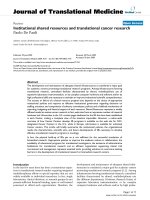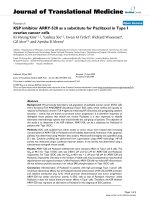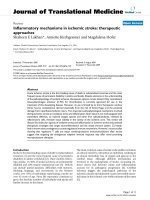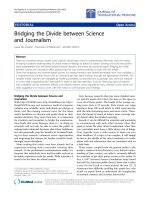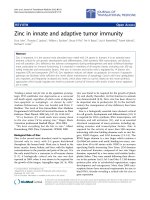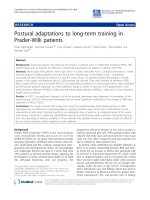báo cáo hóa học: " Appendectomy due to lead poisoning: a case-report" pot
Bạn đang xem bản rút gọn của tài liệu. Xem và tải ngay bản đầy đủ của tài liệu tại đây (180.19 KB, 2 trang )
BioMed Central
Page 1 of 2
(page number not for citation purposes)
Journal of Occupational Medicine
and Toxicology
Open Access
Case report
Appendectomy due to lead poisoning: a case-report
S Mohammadi*
1
, AH Mehrparvar
2
and M Aghilinejad
1
Address:
1
Department of Occupational Medicine and Occupational Medicine Research Center of Iran University of Medical Sciences, Shaheed
Hemmat highway, Tehran, Iran and
2
Department of Occupational Medicine, Yazd University of Medical Sciences, Yazd, Iran
Email: S Mohammadi* - ; AH Mehrparvar - ;
M Aghilinejad -
* Corresponding author
Abstract
Background: Lead poisoning is a common occupational health hazard in developing countries and
many misdiagnoses and malpractices may occur due to unawareness of lead poisoning symptoms.
Case presentation: We report a case of occupational lead poisoning in an adult battery worker
with abdominal colic who initially underwent appendectomy with removal of normal appendix.
Later on he was diagnosed with lead poisoning and was treated appropriately with lead chelator
(CaNa
2
EDTA).
Conclusion: Lead poisoning is frequently overlooked as the differential diagnosis of acute
abdomen which may result in unnecessary surgery. Appropriate occupational history taking is
helpful in making a correct diagnosis. Occupational lead poisoning is a preventable disorder and a
serious challenge for the health and labor authorities in developing countries.
Background
Lead is present in trace amounts in all soils, water, and
foods. Currently, lead is used in more than 900 industries,
including mining, smelting, refining, battery manufactur-
ing, soldering, and so on. [1]
Lead toxicity today is recognized as a major environmen-
tal health risk, with the most serious effects in young chil-
dren. [1] But owing to insufficient controlling measures in
work places, lead poisoning is yet a common occupa-
tional health hazard in developing countries and many
misdiagnoses and malpractices can occur due to unaware-
ness of lead poisoning as an imitator of many organ
symptoms. [2]
Case-report
Our patient is a 41 year-old married male (with 3 chil-
dren, the eldest being 7) living in Tehran. His medical his-
tory did not show any other disease or hospitalization. He
is a heavy smoker (about 30 pack-year). He has been
working as an operator of a machine used to cut and fin-
ish lead plates for 14 years in a battery-manufacturing
plant. He used to work in a lead smelting plant for 2 years
before his current job.
He has had severe abdominal colic since 4 months ago.
He was admitted in a hospital with the diagnosis of
appendicitis and underwent an appendectomy operation
(pathology revealed normal tissue of appendix) without
any improvement in symptoms. He has also had other
symptoms including headache, lethargy, fatigue, irritabil-
ity, insomnia, muscle pain (especially in the legs), consti-
Published: 17 October 2008
Journal of Occupational Medicine and Toxicology 2008, 3:23 doi:10.1186/1745-6673-3-23
Received: 27 June 2006
Accepted: 17 October 2008
This article is available from: />© 2008 Mohammadi et al; licensee BioMed Central Ltd.
This is an Open Access article distributed under the terms of the Creative Commons Attribution License ( />),
which permits unrestricted use, distribution, and reproduction in any medium, provided the original work is properly cited.
Publish with BioMed Central and every
scientist can read your work free of charge
"BioMed Central will be the most significant development for
disseminating the results of biomedical research in our lifetime."
Sir Paul Nurse, Cancer Research UK
Your research papers will be:
available free of charge to the entire biomedical community
peer reviewed and published immediately upon acceptance
cited in PubMed and archived on PubMed Central
yours — you keep the copyright
Submit your manuscript here:
/>BioMedcentral
Journal of Occupational Medicine and Toxicology 2008, 3:23 />Page 2 of 2
(page number not for citation purposes)
pation, decreased libido, nausea, vomiting, tremor, loss of
appetite, and weight loss.
After discharge from hospital without any improvement,
he was referred to occupational medicine clinic of Tehran
University of Medical Sciences with suspicion of lead
intoxication by an occupational medicine specialist who
was in charge of medical examinations of the workers in
that plant.
When we visited him, he had the aforementioned abdom-
inal pain. Upon physical examination he was afebrile
(37.2°C oral) with respiratory rate of 14/min and pulse
rate of 82/min. His blood pressure was 145/90 mmHg.
His conjunctivae were pale; he had a mild tenderness in
deep abdominal palpation and a surgery scar on his right
lower quadrant. Blood test revealed a blood lead level of
118 μg/dl. However, he didn't have any other symptoms
such as lead lines or symptoms related to neuropathy. The
results of other laboratory tests are as follows:
Three months after appearance of symptoms: WBC 6.8 ×
10
3
, RBC 4.3 × 10
6
, Hb 10.9, Hct 35.1, MCV 80.1, MCH
24.9, MCHC 31.1, PLT 255 × 10
3
.
One month later (after admission): Hb 9.7, Hct 29.8,
MCV 81, MCH 26.4, MCHC 32.5.
He was treated with continuous IV infusion of CaNa
2
-
EDTA 1 g Bid for 5 days. During treatment his renal func-
tion was evaluated on a daily basis. After starting the treat-
ment his symptoms improved and he was discharged
from hospital. After 2 weeks his blood lead level was 38.3
μg/dl. Upon complete recovery he returned to his job at
his former workplace.
Discussion
Lead intoxication is highly prevalent among persons
chronically over-exposed to lead. Symptoms include
arthralgia, myalgia, headache, weakness, depression, loss
of libido, impotence, and vague gastrointestinal prob-
lems. [3] The first gastrointestinal symptoms begin to
appear at blood lead level around 80 μg/dl. They consist
of loss of appetite, digestive disturbances, epigastric dis-
comfort after meals, and either constipation or diarrhea.
When the blood lead level exceeds 100 μg/dl, the likeli-
hood of more severe symptoms increases. These include
occasional or frequent abdominal colic and severe consti-
pation. If exposure does not stop, classic lead colic devel-
ops [4], which often results in inappropriate laparatomy.
[5]
In our country, the main sources of occupational lead poi-
soning are battery-manufacturing plants, lead smelting
plants, and steel plants. We do not have any specific limit
values and use ACGIH-TLVs as regulatory measures for
blood lead (50 μg/dl in two occasions needs removal
from work).
Our patient worked in a battery-manufacturing plant and
had typical symptoms and signs of lead poisoning; he was
also inappropriately operated for appendicitis.
Lead intoxication symptoms such as abdominal pain,
constipation, nausea, vomiting, etc make this disease an
important diagnosis to be differentiated from many gas-
trointestinal and surgical diseases, and the significant
point is that lead intoxication is preventable and its treat-
ment is straightforward. Therefore, paying attention to a
good occupational history will prevent many unnecessary
and/or avoidable medical interventions.
Competing interests
The authors declare that they have no competing interests.
Authors' contributions
SM and AHM contributed in visiting the case, MA contrib-
uted in editing the manuscript, all authors contributed in
drafting the manuscript, all authors read and approved
the final manuscript.
Consent
Written informed consent was obtained from the patient
for publication of this case report. A copy of the written
consent (in Persian) is available for review by the Editor-
in-Chief of this journal.
References
1. Habal R: Lead toxicity. [ />topic1269.htm].
2. ILO Encyclopedia of Occupational Health and Safety, Lead, 63.19; Geneva
4th edition. 1998, III:.
3. Moline JM, Landrigan JP: Lead. In Text book of Clinical Occupational and
Environmental Medicine 2nd edition. Edited by: Rosenstock L, Cullen
MR, Brodkin CA, Redlich CA. ELSEVIER Inc; 2005:967-78.
4. Saryan LA, Zenz C: Lead and its compounds. In Occupational Med-
icine 3rd edition. Edited by: Zenz C. USA: Mobsy; 1994:506-548.
5. Kehoe RA: Occupational lead poisoning: Chemical signs of the
absorption of lead. J Occup Med 1972, 14(5):390-396.

